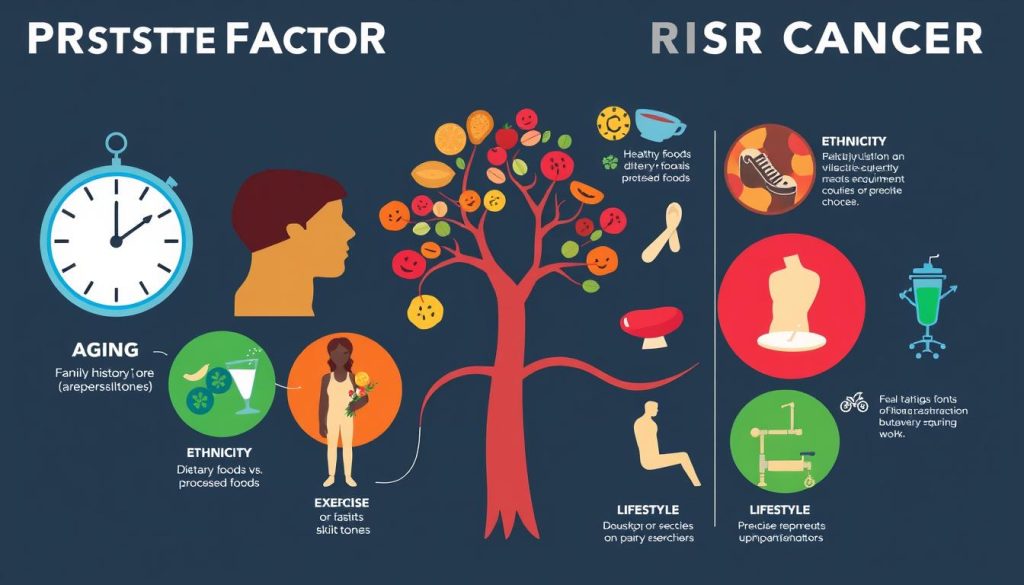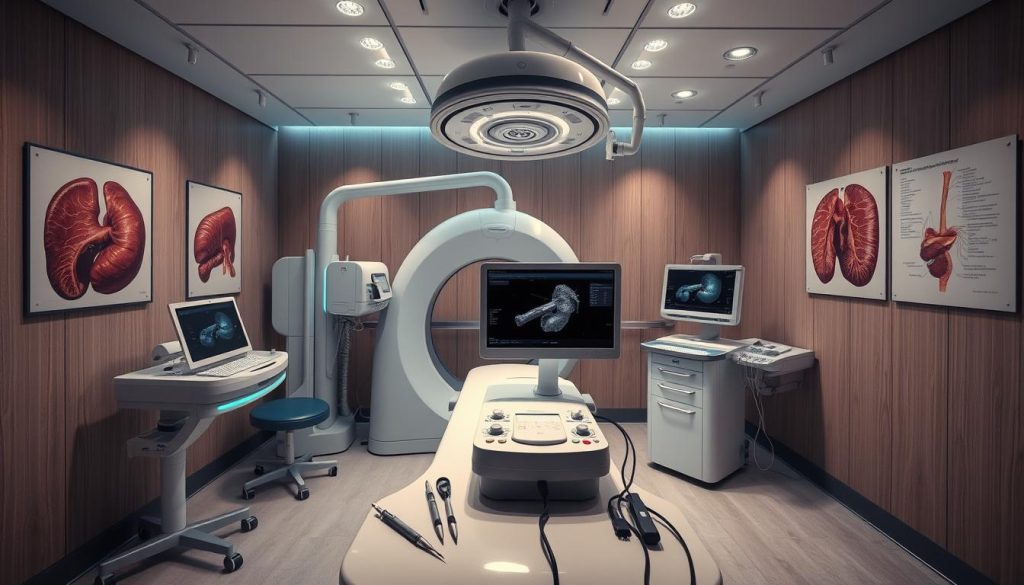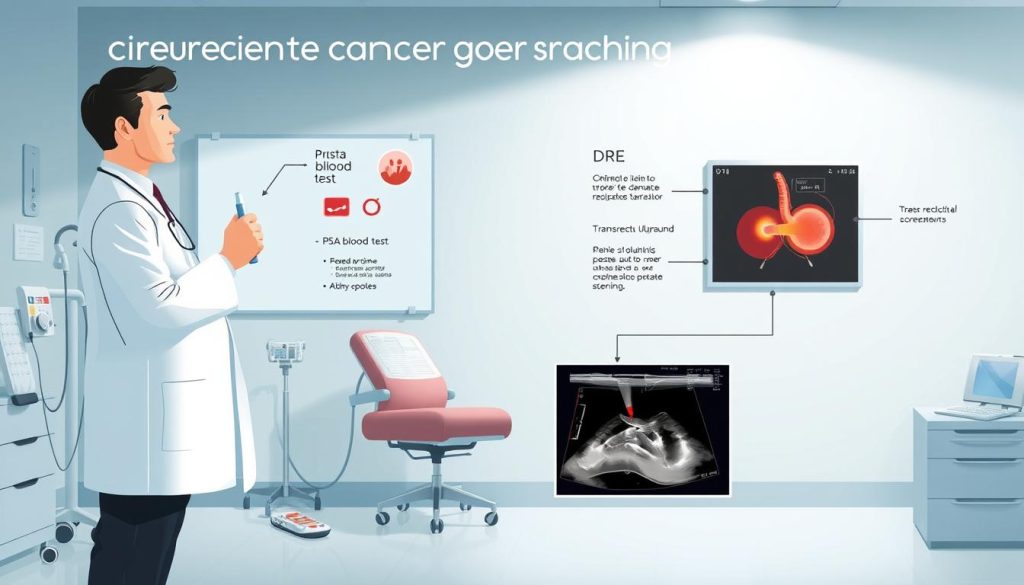Prostate cancer screening is key to finding cancer early and improving treatment chances. Experts say men should get regular check-ups to spot problems early. Learning about the diagnosis process helps people take charge of their health.
Diagnosing prostate cancer involves several steps. These include assessing risk and using advanced imaging. Each step gives important clues. Finding cancer early can greatly improve treatment choices and outcomes.
Things like age, family history, and ethnicity affect when to start screening. Knowing these helps decide when to have regular prostate exams. We’ll look at the tools and tests used to find prostate cancer accurately.
Understanding Prostate Cancer: Signs and Symptoms to Watch For
It’s vital to know the signs of prostate cancer for early detection. This disease often grows quietly, so noticing small changes is key. Let’s look at the common signs that might show prostate cancer.
Common Physical Symptoms
Prostate cancer can show in different ways. These symptoms include:
- Unexplained weight loss
- Bone pain, especially in the hips, spine, or ribs
- Erectile dysfunction
- Blood in semen
Urinary Changes and Warning Signs
Urinary changes are often the first signs of prostate cancer. Watch for:
- Frequent urination, especially at night
- Difficulty starting or stopping urination
- Weak or interrupted urine flow
- Burning sensation or pain during urination
- Blood in urine
When to Seek Medical Attention
Seeing a doctor early is crucial for treating prostate cancer. If you notice:
- Persistent urinary changes
- Chronic pain in the lower back, hips, or upper thighs
- Difficulty getting or maintaining an erection
- Blood in urine or semen
These symptoms don’t always mean cancer, but they need a doctor’s check-up. Regular tests are key for catching prostate cancer early, especially for men over 50 or those at higher risk.
Risk Factors and Early Detection Guidelines
Knowing the risk factors for prostate cancer is key to catching it early. Men over 50 are at a higher risk. Family history and ethnicity also play a part.

Screening guidelines vary based on your risk level. The American Cancer Society suggests talking to your doctor about screening. Early detection often includes PSA tests and digital rectal exams.
Men with average risk usually start screening at 50. Those with higher risk may start earlier. It’s important to think about your health, preferences, and values when deciding on screening.
| Risk Level | Recommended Screening Age | Screening Frequency |
|---|---|---|
| Average Risk | 50 years | Every 1-2 years |
| High Risk | 45 years | Annually |
| Very High Risk | 40 years | Annually |
Regular check-ups and talking openly with your doctor are crucial for prostate health. By knowing the risk factors and following screening guidelines, you can take steps towards early detection and treatment.
Initial Screening Methods and Tests
Finding prostate cancer early is key to treating it well. Two main tests are used: the digital rectal exam and the PSA blood test. These help doctors spot problems and decide if more tests are needed.
Digital Rectal Examination (DRE) Procedure
The digital rectal exam is a physical check. A doctor feels the prostate gland for any oddities. They use a gloved finger in the rectum to check size, shape, and feel.
This exam might be a bit uncomfortable but is quick. It can give vital clues about the prostate’s health.
PSA Blood Test Understanding
The PSA test checks the prostate-specific antigen in your blood. High levels might mean cancer, but can also show other issues. Prostate cancer is usually first found through this test, as early cancers don’t show symptoms. It’s often paired with the digital rectal exam for a full check.
Frequency of Screening Recommendations
How often you should get screened for prostate cancer depends on your age and risk. Here’s a basic guide:
| Age Group | Risk Level | Recommended Screening Frequency |
|---|---|---|
| 40-49 | High Risk | Annual |
| 50-69 | Average Risk | Every 1-2 years |
| 70+ | All | Discuss with doctor |
Talking to your doctor about your screening needs is crucial. They can tailor a schedule for you based on your risk and health.
How Is Prostate Cancer Diagnosed: Complete Testing Process
Diagnosing prostate cancer involves several steps. It starts with screening tests and may include more detailed tests if needed. Knowing about these steps can help men feel more ready and less worried about their health.
The first step in how prostate cancer is diagnosed often starts with a PSA blood test and a digital rectal exam (DRE). These tests can show if more tests are needed. If the results are concerning, a doctor might suggest more tests to confirm or rule out prostate cancer.
Advanced tests may include:
- MRI scans to see the prostate gland
- Transrectal ultrasound to guide biopsies
- Prostate biopsy to check tissue samples
New blood tests for cancer are changing how we screen for prostate cancer. These tests could help find cancer earlier and improve treatment results.
“Early detection is key in fighting prostate cancer. Regular screening can save lives.”
The steps to diagnose prostate cancer can change based on risk factors and symptoms. Here’s a typical timeline for diagnosis:
| Step | Procedure | Timeframe |
|---|---|---|
| 1 | Initial PSA test and DRE | 1-2 weeks |
| 2 | Follow-up tests (if needed) | 2-4 weeks |
| 3 | Prostate biopsy | 1-2 weeks |
| 4 | Biopsy results and diagnosis | 1-2 weeks |
Early detection through regular screening can greatly improve treatment results. Always talk to a healthcare provider about the best screening schedule for you.
Advanced Diagnostic Techniques and Imaging
Prostate cancer screening is getting better thanks to new diagnostic techniques. These advanced methods help find cancer early and understand its extent. They give doctors the details they need to make the right treatment plans.
MRI Fusion Biopsy
MRI fusion biopsy uses magnetic resonance imaging and ultrasound together. It lets doctors precisely target and check suspicious areas. This method is more accurate than old biopsy ways.
Bone Scans and CT Scans
Bone scans check if prostate cancer has spread to bones. They use a tiny amount of radioactive material that shows up in abnormal bone areas. CT scans show detailed images of the body, helping find cancer in other organs or lymph nodes.
PET Scanning for Prostate Cancer
PET scans are a key tool for finding prostate cancer. They use a radioactive tracer to light up cancer cells in the body. This method is great for spotting cancer that has come back or spread.
These new diagnostic tools help find prostate cancer early. They give doctors important details about the cancer’s size, location, and spread. This information helps doctors make treatment plans that fit each patient’s needs.
Prostate Biopsy: Procedure and Results
A prostate biopsy is a key step in diagnosing prostate cancer. It involves taking small tissue samples from the prostate gland. These samples are then examined under a microscope. Let’s explore the types of biopsies, what to expect during the procedure, and how to interpret the results.
Types of Prostate Biopsies
There are two main types of prostate biopsies:
- Transrectal biopsy: The most common method, where a needle is inserted through the rectum wall.
- Transperineal biopsy: A needle is inserted through the skin between the scrotum and rectum.

What to Expect During the Procedure
During a prostate biopsy, you’ll lie on your side with your knees pulled up to your chest. The doctor will use a thin needle to extract several small tissue samples. The procedure typically takes about 10-15 minutes and may cause brief discomfort. Your doctor might recommend local anesthesia to minimize any pain.
Understanding Biopsy Results
After the biopsy, a pathologist examines the tissue samples. Results usually come back within a few days to a week. The report will indicate whether cancer cells are present and, if so, provide a Gleason score. This score helps determine the aggressiveness of the cancer and guides treatment decisions.
“A prostate biopsy is a crucial diagnostic tool in how prostate cancer is diagnosed. It provides definitive evidence of cancer presence and its characteristics.”
Remember, a biopsy is just one part of the diagnostic process. Your doctor will consider these results along with other tests to make an accurate diagnosis and develop an appropriate treatment plan.
Staging and Grading of Prostate Cancer
Knowing the stages of prostate cancer is key to choosing the right treatment. Doctors use tests to see how far the cancer has spread and how aggressive it is. This helps decide the best treatment and gives patients a clear understanding of their situation.
The TNM system is often used to stage prostate cancer. ‘T’ shows the tumor size, ‘N’ if lymph nodes are involved, and ‘M’ if the cancer has spread. Stages go from I to IV, with higher numbers meaning more advanced cancer. Early detection is crucial for better outcomes, as explained here.
Grading prostate cancer uses the Gleason score, which looks at how abnormal the cancer cells are. A higher score means the cancer is more aggressive. Knowing both the stage and grade helps doctors and patients decide on treatment. Treatments can range from watching the cancer closely to more aggressive methods like surgery or radiation.
Every case is different. Your doctor will explain what your stage and grade mean for your treatment. It’s important to stay informed and ask questions to fully understand your diagnosis and what’s ahead.
FAQ
Q: What are the main symptoms of prostate cancer?
A: Symptoms of prostate cancer include frequent urination, especially at night. You might also have trouble starting or stopping urination. Weak or interrupted urine flow is another sign.
Painful or burning urination, blood in urine or semen, and erectile dysfunction are symptoms too. But, early-stage prostate cancer often has no symptoms. That’s why regular screening is key for early detection.
Q: At what age should men start getting screened for prostate cancer?
A: Men should talk to their doctor about prostate cancer screening at:
– Age 50 for those at average risk
– Age 45 for those at high risk, like African Americans or those with a family history
– Age 40 for those at even higher risk, with more than one first-degree relative diagnosed early
Q: What is a PSA test and how is it used in prostate cancer screening?
A: A PSA test measures the level of PSA in a man’s blood. PSA is a protein made by the prostate gland. High levels can mean prostate cancer or other issues.
It’s a first step in screening. But, if the results are abnormal, more tests are needed to confirm or rule out cancer.
Q: What happens during a digital rectal exam (DRE)?
A: During a DRE, a doctor puts a gloved, lubricated finger into the rectum. They feel the prostate gland for any abnormalities. It might be uncomfortable, but it’s brief and helps check prostate health.
Q: How accurate is a prostate biopsy in diagnosing cancer?
A: A prostate biopsy is the most accurate way to diagnose prostate cancer. But, its accuracy can vary. Traditional biopsies have a 20-30% false-negative rate.
More advanced techniques like MRI-guided biopsies can improve accuracy. Always discuss the results with your doctor and consider more tests if cancer is suspected despite a negative biopsy.
Q: What are the different stages of prostate cancer?
A: Prostate cancer is staged using the TNM system:
– T (Tumor): Describes the size and extent of the main tumor
– N (Nodes): Indicates whether cancer has spread to nearby lymph nodes
– M (Metastasis): Shows if cancer has spread to other parts of the body
Stages range from I (early-stage, confined to the prostate) to IV (advanced, spread beyond the prostate). The stage helps determine treatment options and prognosis.
Q: Can prostate cancer be detected through a urine test?
A: Some urine tests can help detect prostate cancer, though they’re not a primary diagnostic tool. For example, the PCA3 test measures a specific gene in urine samples. These tests are used alongside other screening methods to improve detection, especially when PSA results are unclear.
Q: What is an MRI fusion biopsy?
A: An MRI fusion biopsy uses MRI imaging and real-time ultrasound to guide the biopsy needle. It targets suspicious areas of the prostate more precisely. This technique is better than traditional biopsies for patients with previous negative biopsies but still suspect cancer.


















